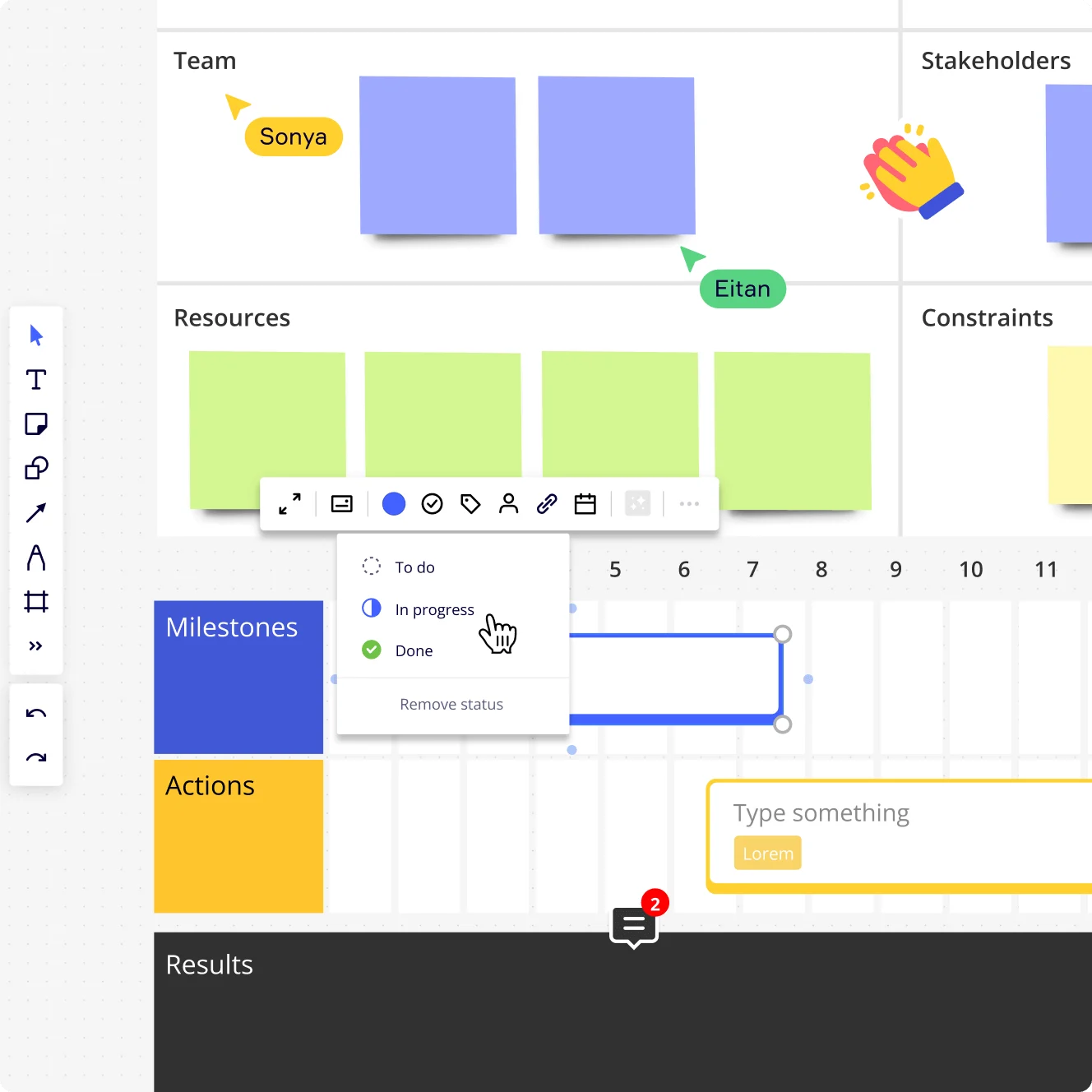
Project scheduling techniques for success

Summary
In this guide, you will learn:
Common project scheduling techniques like CPM, PERT, Gantt, Agile, and resource leveling for efficient workflows and deadlines.
How to build an effective project schedule through WBS, critical path mapping, task duration estimation, goal definition, and regular reviews.
The detailed process of implementing CPM: mapping tasks and dependencies, calculating durations, building timelines, tracking progress, and communicating the critical path.
The role of AI and automation in project scheduling, including predictive scheduling, resource optimization, and automated updates.
How Miro’s innovation workspace supports project scheduling with visual roadmapping, real-time collaboration, templates, and an AI-powered canvas.
Practical use of Miro's schedule templates for visual task organization, customized timeframes, event addition, and team collaboration with color-coding and document integration.
Try Miro now
Join thousands of teams using Miro to do their best work yet.
About project scheduling techniques
Project scheduling techniques play a vital role in ensuring successful project delivery. By effectively managing and organizing the various tasks and resources involved, project scheduling techniques streamline workflows, optimize productivity, and enhance overall project outcomes.
It is crucial to understand its significance and core components. By visualizing the project timeline, identifying task dependencies, and allocating resources efficiently, project scheduling empowers project managers to effectively plan, execute, and monitor projects.
Benefits of project scheduling techniques
Enhance Efficiency: Project scheduling techniques enable teams to prioritize tasks, allocate resources optimally, and eliminate bottlenecks, leading to improved productivity and streamlined workflows.
Improved Time Management: By breaking down the project into smaller, manageable tasks with realistic deadlines, project scheduling techniques enable accurate time estimation and effective time allocation.
Proactive Risk Management: Proper project scheduling allows project managers to anticipate and address potential risks and delays, ensuring timely mitigation and proactive decision-making.
Common project scheduling techniques
There are many project scheduling techniques that can help you to streamline workflows and optimize productivity. These are some of the more commonly used ones:
Critical Path Method (CPM):
Define the critical path representing the longest sequence of dependent tasks, allowing project managers to identify tasks that directly impact the project timeline. Determine the project's earliest start and finish dates and the slack time available for non-critical tasks.
Program Evaluation and Review Technique (PERT)
Employed in complex projects with inherent uncertainties, PERT utilizes statistical analysis to estimate task durations and identify critical paths. Incorporate optimistic, pessimistic, and most likely time estimates to calculate the expected duration for each task.
Gantt Charts
Display project tasks, their durations, and their interdependencies in a visual timeline format. Aid in tracking progress, identifying overlaps or delays, and providing an overview of the project's schedule.
Agile scheduling
Agile methodologies, such as Scrum or Kanban, offer iterative and flexible approaches to project scheduling. Prioritize tasks, work in short sprints, and regularly reassess and adapt the schedule based on evolving project requirements.
Resource leveling
Ensure optimal resource utilization by balancing resource allocation across multiple projects and avoiding resource overloads or conflicts.Evaluate resource availability, adjust task assignments, and reallocate resources as needed to maintain a balanced project schedule.
Best practices for effective project scheduling
Successful project scheduling relies on incorporating industry best practices. Consider the following guidelines:
Clearly define project objectives: Establish specific, measurable, achievable, relevant, and time-bound (SMART) project goals to guide the scheduling process.
Break down tasks: Decompose the project into smaller, manageable tasks to facilitate accurate estimation, resource allocation, and tracking.
Identify task dependencies: Determine task interdependencies to understand the sequence and relationship between tasks, ensuring a logical project flow.
Accurate task duration estimation: Leverage historical data, expert input, and informed estimation techniques to assign realistic durations to tasks.
Consider resource availability: Evaluate resource availability and skill sets to ensure the right resources are allocated to tasks at the appropriate times.
Regular monitoring and updates: Continuously monitor project progress, update the schedule as needed, and communicate any changes to stakeholders.
Tools and software for project scheduling
When it comes to project scheduling, leveraging the right tools can greatly enhance efficiency and collaboration. Miro offers comprehensive project management tools that facilitate seamless project scheduling, as well as other valuable features.
Miro's Gantt chart maker can help you create and manage Gantt charts effortlessly, visualizing task timelines and dependencies to effectively plan and monitor projects.
If you prefer agile workflows, Miro’s tools for agile teams will help you streamline agile project management, enabling teams to collaborate, track progress, and adapt schedules in real time.
Manage your projects in Miro
Project scheduling techniques are indispensable for project managers looking to maximize their efforts. With Miro, it's easy to build a visually compelling and detailed overview of your projects — and keep everyone in the loop both in real time and async. You'll also have access to plenty of customizable project management templates to kickstart your work. But why not see for yourself? Sign up to get started.
Author: Miro Team
Last update: October 16, 2025